Genital Condyloma Frequency
genital-wart-condyloma-treatment. Genital condylomas are visible lesions of human papillomavirus (HPV) infection, which has more than 120 types.1More than thirty HPV types are known to be specific to the anogenital region.1,2 It is estimated that between 20% and 40% of sexually active women are infected with HPV.3About 15 of the anogenital site-specific HPV types are classified as high-risk or oncogenic.2Although low-risk HPV types play a role in the formation of genital condylomas, it should be kept in mind that more than one HPV type in the same patient is highly likely to cause infection.3,4
Risk factors
The two main factors affecting the incidence of genital condylomas are age and sexual behavior. Condylomas are transmitted by sexual activity; It is rarely seen in people who do not have sexual activity.It is known that the prevalence is highest in sexually active women between the ages of 18-25.3, The primary mode of transmission in women is vaginal sexual intercourse. The virus can also be transmitted by digital-anal, oral-anal and digital-vaginal contact. Anal condylomas are caused by the spread of vulvar or perineal infections or by anal intercourse.8The risk of infection increases as the number of sexual partners increases.3 HPV infection is more common in the presence of other sexually transmitted diseases or oral herpes.3,4,8 In HIV positive cases, the immune system is also suppressed; therefore, condylomas are more common, but this rate has been observed to decrease in those receiving antiretroviral therapy.9,10
It is thought that genital condylomas seen in children are mostly caused by sexual abuse, but sometimes it is also transmitted from the mother.3Vertical transmission in pregnant women infected with HPV can occur both through the transplacental route and during vaginal delivery.3,11 HPV can cause mucosal, conjunctival and laryngeal lesions in newborns. Having a cesarean section does not reduce the risk of vertical transmission.12

Condyloma Treatment Methods
Spontaneous regression can be seen in 30% of patients with genital condyloma, with the effect of both humoral and cellular immunity.1,13 However, regression does not indicate complete clearance of the virus because viral genomes can be detected in normal epithelium even months or years after visible lesions have healed.1
Since healing of visible lesions does not mean that the virus is not found in healthy-appearing tissues, treatment is aimed at removing or chemically or physically destroying the lesions rather than eradicating HPV infection.1Today, there are also immunological treatment methods. However , the superiority of one treatment method over the other has not been shown.1,4,8 The treatment methods to be preferred may be different according to the characteristics of the regions where the condylomas are located.2
Recurrence can be observed at a rate of 30% to 70% after treatment.8 Evaluation and treatment of sexual partners of patients with genital condyloma for HPV infection is not essential for patient management because reinfection is not thought to play a role in recurrences.2,4
Chemical Agents
Chemical agents used in the treatment of genital condylomas are podophylline, trichloroacetic acid (TCA) and 5-fluorouracil (5-FU)/epinephrine gel.3
Podophylline
Podophyllum, an extract of podophyllum peltatum, contains podophyllotoxin, an antimitotic agent.4 It causes cell death by stopping the cell cycle at metaphase.When the topical 25% podophylline solution is used as a single agent once or twice a week, it can be successful at a rate of 20-50%.14The solution is only applied onto the lesion; it is allowed to dry and then washed within 6 hours.8
On the other hand, it should never be applied to the cervix, vagina, urethra and perianal area as it will cause chemical burns.4 Administration of podophylline during pregnancy is contraindicated as it may have a teratogenic effect.4 Mild skin irritation, sometimes ulceration and pain can be seen as side effects.8 It can cause serious systemic side effects such as nausea, vomiting, fever, kidney failure, ileus, leukopenia, neurotoxicity when applied to large areas or mucosal surfaces, or when left on the skin for a long time without washing.8,15
0.5% podofilox (podophyllotoxin), a similar agent to podophyllin, can be self-administered by the patient.8 It is applied on the lesion twice a day for three days; then rest for 4 days. This treatment cycle can be repeated up to 4 times until the lesion disappears.4The amount of drug per application should not exceed 0.5 mL and the application area should not exceed 10 cm2.8

Trichloroacetic Acid (TCA) or Bichloroacetic Acid (BCA)
TCA of 80-90% causes coagulation of proteins and destroys condylomas.8 Bichloroacetic acid has the same effect upon. Treatment rates and side effects are similar to podophylline. It is applied directly on the lesion with a cotton swab. This application can be repeated 1-3 times a week for 4-6 weeks.4,16 Contrary to podophylline, it can be used for mucosal lesions and during pregnancy.4,8 During the application, the surrounding healthy skin can be protected by applying cream or gel.8 The success rate of 70% for treatment has been reported by means of TCA.17
5-Fluorouracil (5-FU)/Epinephrine Gel
FU is a pyrimidine antimetabolite. It impairs DNA synthesis by inhibiting the methylation of deoxyuridylic acid; thus leading to cell death.8 The gel containing 5-FU and epinephrine is squeezed into the lesion. It can be applied once a week for 6 weeks.8It is not used very often in practice due to its side effects and not having FDA (Food and Drug Administration) approval.4
Immunological Treatment
Among the immunomodulatory agents, imiquimod and interferon-a are used in the treatment of genital condylomas.8 Studies with sinecatechins are also promising.18
Imiquimod (Aldara Cream)
Imiquimod (Aldara) positively modifies the immune response by inducing local cytokines.4,8 It is applied topically in the form of 19,5% cream. It is effective at the rate of 72-84% in the treatment of condylomas; recurrence may develop at a rate of 5-19%.5,15 By means of imiquimod treatment, the lesion may shrink even if it does not disappear completely.8 Apart from genital condylomas, imiquimod can also be used in the treatment of vulvar and anal intraepithelial neoplasms.20
Imiquimod should not be applied to mucosal surfaces.4Cream is applied on the lesion and washed off after 6-10 hours.4It can be self-administrated 3 times a week by the patient at home. The application lasts a maximum of 16 weeks.4,8 The most prominent side effect is forming mild to moderate local erythema.8It has no systemic side effects and its pregnancy category is C.4
Interferon-a
Interferon-a can be applied systemically or within the lesion, but it has not been approved by the Food and Drug Administration (FDA) for the treatment of anogenital condylomas.8Although it is not frequently used in clinical practice, it has been shown that recurrences can be reduced with local or systemic use after surgical excision or destructive treatments.8 It is contraindicated in pregnancy.4 It may cause systemic side effects; Leukopenia and increase in liver enzymes may occur in treatments longer than 3 weeks.15
Sinecatechins
Sinecatechins (eg. Veregen) are herbal agents that can be self-administered topically. Kunecatechin, the active ingredient in sinecatechins, is a mixture of catechins and other green tea ingredients. Although not certain, catechin is thought to have both antioxidant and immune-enhancing effects as well as antiviral effects.21Veregen cream is administrated 3 times a day on anogenital condylomas until all lesions disappear or for a maximum of 16 weeks. The risk of recurrence with this treatment is less than 10%.18 Local side effects such as itching, erythema, pain, inflammation and ulceration have been reported. There is not enough information about its use in pregnancy. FDA approved for use in the treatment of external genital and perianal condylomas in men and women over 18 years of age.4
Surgical treatment
Ablative or excisional surgical treatment is applied in cases that do not respond to medical treatment or in condylomas that are suitable for surgical removal.8Cryotherapy and electrocautery can be applied as office procedures, while operating room conditions are needed for laser and excisional treatment.
Cryotherapy
Cryotherapy is usually performed by spraying liquid nitrogen on the lesion or applying cryoprobes cooled with nitrous oxide on the lesion.8This procedure can also be used safely during pregnancy.4 Pain during the application and inflammation after it can be seen as a side effect. Treatment success within 3 months has been reported as 63-92%.8However, recurrence can be observed at rates of up to 38-73% after 6 months of treatment.15Application can be repeated in case of treatment failure. Nitrous oxide is not used for vaginal lesions, but is preferred for cervical lesions.8
Electrocauterization
One of the physical ablative methods is electrocauterization.3 It is not a preferred method since it can create scar tissue. It also requires anesthesia as it is a painful procedure.3
Laser therapy
CO2 or NDYag laser can be applied in condylomas, but it requires operating room conditions and anesthesia. It is more useful to guide the procedure with colposcopy. The laser transforms into heat energy and causes the vaporization of condylomas to perform destructive treatment.8Tissue damage should not be deeper than 1 mm.8Although treatment success approaches 100% at the end of the first year, it can develop at a rate of 45% later.22 The most important side effects are scar formation and pain. Its disadvantage is the high cost.
Excisional Methods
Excision with a scalpel or scissors requires anesthesia and has surgical risks such as infection and bleeding. At the end of the third month, the success of the treatment is 36%.22However, recurrence can be observed in 19-29% of patients 1 year after excision.15The lesion is excised up to the skin level and the bottom is cauterized.8 Cauterization of subcutaneous or submucous adipose tissue can lead to strictures.8The advantage of this treatment method is the chance of pathological diagnosis.
Large condylomas in the birth canal in pregnant women can cause soft tissue dystocia. Aggressive surgical treatment is required in such lesions, or cesarean section may be preferred as the delivery method. According to the current literature, the presence of lesions that do not prevent the progress of labor does not constitute an indication for cesarean section in order to reduce the risk of progress to the newborn.12
LEEP (Loop Electrosurgical Excisional Procedure)
LEEP is one of the methods that can be used in the treatment of perineal condylomas.4 Although HPV DNA particles are detected in the smoke formed when laser or electrocoagulation is used for excision, it is not known whether the viruses maintain their viability, but it is still recommended that surgeons use a protective mask that prevents the passage of virus particles.4Anesthesia is required during the procedure. The main side effects of this treatment method are late bleeding and scar formation.4 A success rate of 90-96% is reported in lesions outside the cervix.4
Ultrasonic Aspiration
The CUSA (cavitron ultrasonic aspirator) uses ultrasonographic technology to break up and aspirate condyloma tissue. It does not damage the tissue under the epithelium, but pathological examination of the aspirated tissue may not be possible.23
Topical Antimicrobial Treatment
For this purpose, cidofovir and BCG (bacillus Calmette-Guerin) are used, but more studies are needed for general acceptance of both agents.24.25
Infrared Coagulation
This method causes tissue coagulation by focusing the infrared beam passing through the probe. It is an accepted practice in the ablation of anogenital condylomas, as well as in the treatment of hemorrhoids and tattoo removal. A success rate of 82% has been reported.26
Combined Treatment
Studies using various combinations of destructive treatments, immunomodulatory treatments and surgical treatments in order to increase cure rates and prevent recurrences could not show their superiority over treatment with a single method. However, in resistant cases, interferon can be applied into the lesions together with non-immunomodulatory medical treatments (eg TCA).16
FOLLOW-UP AND CARE AFTER TREATMENT
Preferring analgesics, sitz baths and comfortable underwear following the treatment reduces the patient’s pain and accelerates recovery. Sexual activity is restricted until clinical improvement is achieved. The first control examination can be planned 3-6 months later, then a routine gynecological control examination program is applied. However, due to the high risk of recurrence in immunocompromised cases, more frequent controls are required.
Prevention of genital condyloms
Barrier Methods
Although condom and similar barrier methods used during sexual intercourse reduce the passage, they cannot completely prevent it.3
HPV Vaccines
Two types of vaccines have been developed to prevent HPV infections:
-Quadrivalan vaccine; Against HPV types 6, 11, 16, 18 (Gardasil)
-Bivalent vaccine; Against HPV types 16 and 18 (Cervarix)
These vaccines, which are recommended to be administered between the ages of 9-26, are useful in the primary prevention of HPV infections; however, their use for the treatment of condyloma or for the prevention of recurrences after treatment is experimental and is not currently recommended.











